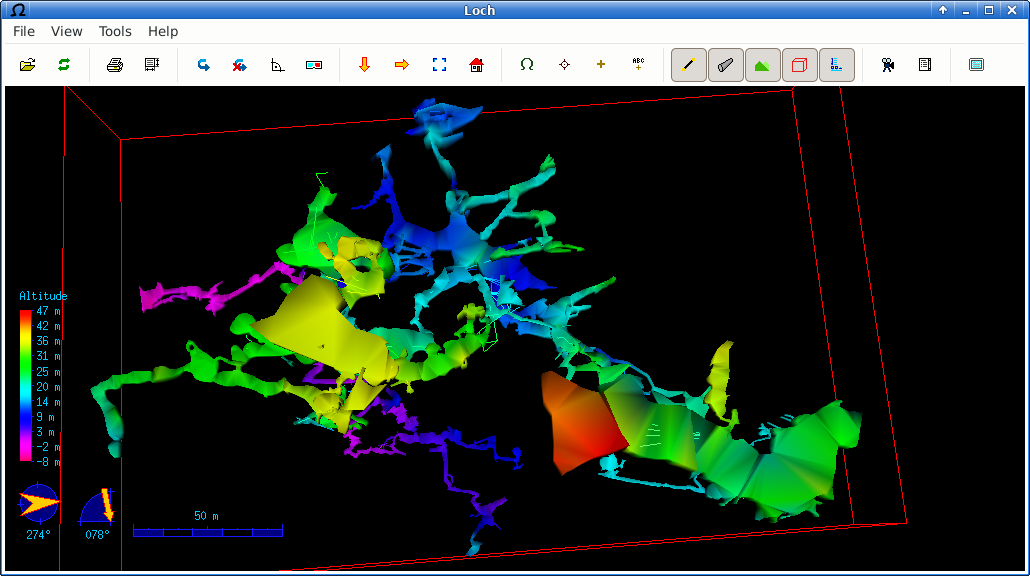ORCID 0000-0002-5894-8705
Current speleological projects: sandstone pseudokarst around the Sydney sandstone areas; gravels at Jenolan (currently inaccessible) and looking at possible ice-age forms in caves at Wombeyan. Jill is preparing a book on Fig Tree Cave at Wombeyan Caves, NSW, using maps and models of Fig Tree Cave and Victoria Arch, a large showcave. This was mapped over many years by members of Sydney University Speleological Society (SUSS). The large arch was scanned by R. Zlot and the point cloud used to correct that part of the cave map. A small preliminary plan was published in the SUSS Bull. This is the first time the whole cave has been modelled. Software tools of choice: cavern, aven, therion, xtherion and loch, with gvim for general editing on Debian Linux. Cloud Compare was used to view and correct the model of that part of the cave that was laser scanned.
 Screenshot of Fig Tree Cave modelled with 'loch', 140 kB png image. |
| To prepare this image, Jill used gvim to enter the field data, cavern and aven to verify each section, ported to therion (minor edits to fix the format), xtherion to create the cave outline and therion to compile the output into the desired format. Loch is then used to view the model, and a screenshot of the view to create this png file. The advantage of this process is it runs on a machine with a small amount of storage, limited graphics, and it runs brilliantly fast. The downside is it lacks the fine detail available from the point cloud. For Victoria Arch, the point cloud is wonderful and shows plenty of detail, but it is only a portion of the whole cave. To merge the point cloud data with the compass / clino and disto data, Jill took sections using Cloud Compare, and used them as outlines in xtherion. On Jill's small computer, Cloud Compare runs slowly. It's best run without any other applications as it needs as much memory as possible. |
Jill is also writing the cave description and geomorphology, a deep rat-hole through geological time! Distractions include evidence of past ice-ages, dust storms and old bones, maybe the start of the Sydney Basin, some current streamway dynamics leaving sculptural forms and even some ancient hydrothermal action. Software tool for publication is pdflatex.
History: Jill Rowling has been caving since 1988 when she was introduced to the hobby by her (then) fiancee, Dr Mike Lake. She is a member of Sydney University Speleological Society (SUSS), the Sydney Speleological Society (SSS) and ACKMA, the Australasian Cave Karst Managers Association http://www.ackma.org/index.html
Ever since she was taken to a show cave as a child, she has always wanted to know what was the cause of the shapes and patterns that she saw. Frustrated with the usual handwaving arguments for explanations as to the origin of speleothems, she is trying to find more precise reasons for the existance of a number of speleological features such as helictites and microgours. Like the growth of speleothems themselves, discovery takes time. Along the way, there have been a few discoveries such as Ribbon Helictites, the study of which has led to a better understanding of the structure of "normal helictites" (see Articles).
Jill has caved in Australia in New South Wales, Victoria, Tasmania and South Australia; overseas in Fiji, Switzerland and Czech Republic. She has visited Australian showcaves in NSW, Tasmania, South Australia and Western Australia, and overseas in Austria, Czech Republic, New Zealand, Slovakia and Slovenia.
Jill received a Master of Science degree from
the University of Sydney in 2005,
on the topic of "Cave Aragonites of NSW".
The thesis (book) is in Fischer Library
and is available on-line in the Digital Thesis Project,
https://ses.library.usyd.edu.au/handle/2123/694
If the link above does not work, use a general search.
Jill occasionally gets involved in cave politics with the Australian Speleological Federation, the NSW Speleological Council https://nswsc.caves.org.au/ and semi-government bodies.
Ancient history: Jill is an Electrical Engineer (BE, NSW Institute of Technology (now University of Technology Sydney), 1986) with past experience in data communications, disk controllers and microcontroller system development, industrial electronics and radio. Previous work included Unix Systems Administration, looking after several Sun (Solaris 7 and 9), Linux (Red Hat) and Windows 2003 servers, maintenance of electrical and 3D CAD systems, web site maintenance, tape backups / restores and license renewals. These days she uses mainly Debian Linux on a Dell laptop, and occasionally trundles out a vintage MacOSX laptop for textile weaving software.
When she is not investigating cave matters or managing Marlyn Alpaca ( https://www.marlynalpaca.com.au ), Jill can sometimes be found spinning, weaving, quilting, gardening, crocheting or knitting depending on the weather.
Site notes
The colour scheme is still based on the colours you see around cave entrances, while keeping to pastel shades.
The original pages used frames; I decided to ditch them and re-do the navigation using CSS, as some people complained about the frames, and I got annoyed with button images taking ages to download on a dial-up or satellite link.
I've added a few more topics and given the Articles their own page.
Comments may be addressed to jillr at speleonics dot com dot au.